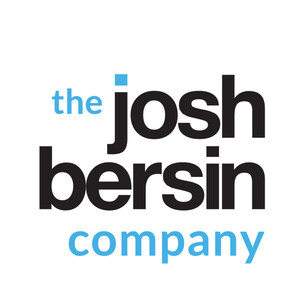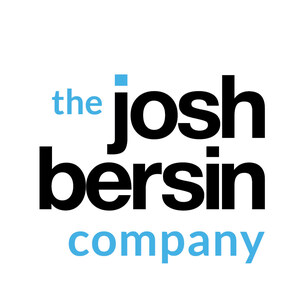- Detailed analysis of 113 U.S. organizations' real-world pay policies reveals current average gender disparity of 15%
- This gap narrows to 10% for female managers—but over a full career, this adds up to millions of dollars in lost financial benefits
- CEOs need to fix this—not just to meet imminent compliance requirements, but to capitalize on the extensive business benefits true pay equity offers
- A key incentive for doing so: pay equity is 13 times more impactful for employee retention and satisfaction than level of pay
OAKLAND, Calif., Aug. 8, 2024 /PRNewswire/ -- The world's most trusted human capital advisory firm, The Josh Bersin Company, today releases an in-depth analysis of the true state of the progress American women are making in closing the gender pay gap. The findings reveal that, despite longstanding efforts, women continue to earn, on average, 15% less than men. At the current pace, full pay equity is not projected to be achieved until 2048.
The research—produced leveraging data from Visier, a leader in cloud-based HR analytics—indicates that better-paid female managers will still need approximately 15 years, rather than a full quarter-century, to close the pay gap.
This data point is particularly significant, as detailed in the full report, The Surprising Truth about Gender Pay Equity. It reveals a crucial aspect of the pay equity issue for the first time: the gender salary imbalance is not solely due to some organizations hiring more women for traditionally "female" and historically lower-paid jobs. Instead, the report shows that even in managerial positions, women earn about 10% less than their male counterparts for the same roles, and this disparity persists even at the executive level.
The experience of even the best-paid women in the American workforce highlights how endemic the gender pay problem is.
On a positive note, the gender pay gap is narrowing. Over the past six years, women have reduced the gap, from 18% to 15%, a 3 percentage point improvement toward parity with their male counterparts. But between 2017 and 2018 and 2022 to 2023, no progress was made, and no progress has occurred since 2020, when the gap was also at 15%.
The gap between female and male managers is closing faster: it has decreased by 4 percentage points over the past six years, dropping from 14% to 10%, which represents a 29% reduction. However, no progress was made between 2019 and 2021, nor between 2022 and 2023.
As a result, the gender pay gap for female managers remained at 10% in 2023. The Josh Bersin Company highlights that this translates to significantly less economic long-term compensation over a career compared to male counterparts with the same skill set and experiences.
The analysis suggests that the situation is likely to change before 2048 due to two key driving forces.
One driving force is the anticipated global impact of the European Union's forthcoming 2026 Pay Transparency legislation. This legislation will mandate that EU companies, as well as external companies conducting significant business within the bloc, record and share salary information. They will also be required to take corrective action if their gender pay gap exceeds 5%.
The law includes provisions for compensating victims of pay discrimination and imposes significant fines on employers who violate the rules.
However, a far more compelling reason to address pay equity is the undeniable bottom-line benefits that organizations experience. According to the report, companies that have successfully resolved the gender pay equity issue see substantial improvements in market performance, customer satisfaction, employee experience, and innovation. Notably, true pay equity is 13 times more important for employee retention and satisfaction than pay level alone, according to a previous in-depth study of the company on pay equity.
To derive these insights, the advisory firm collaborated with Visier, utilizing the Visier Community Data dataset, which comprises 1.65 million employee records from 113 large U.S. enterprises. The findings underscore that equal pay for equal work could halve poverty among working women in the United States and inject an additional $482 billion into the economy. These results, argue analysts at The Josh Bersin Company, amplify the significance of March's first-ever U.S. National Equal Pay Day and should also highlight the contribution of American women in the workforce to next month's International Equal Pay Day.
Kathi Enderes, SVP Research and global industry analyst at The Josh Bersin Company, says:
"There is a 'carrot and stick' approach to achieving gender pay equity for good, and legislation certainly plays a role. But I think the organizations that see that complying with the law is the least important aspect here are the ones that will gain the most, as what matters is the tremendous economic and business gains their companies will gain by putting equity at the heart of not just their DEI work but any business decision."
Josh Bersin, global industry analyst and CEO of The Josh Bersin Company, says:
"Only 5% of companies currently excel at pay equity, with most still working to meet legal and compliance standards. This gap presents a significant opportunity to foster a more equitable environment, drive innovation, and achieve superior business results. However, if progress doesn't accelerate, can we as a society afford to wait until 2048 to close the pay equity gap? Particularly given that the number of college-educated women in the workforce has now surpassed that of their male counterparts, such a delay would represent a substantial missed opportunity for the U.S. economy."
The Surprising Truth about Gender Pay Equity study aims to inform and inspire employers seeking to enhance their payment practices. This research offers actionable insights from companies like Salesforce, TetraPak, and SAP, who are actively addressing the gender pay gap. Additionally, the study includes a comprehensive "Pay Equity Action Guide" to assist organizations in implementing effective strategies.
About Visier
Visier is the recognized global leader in people analytics, providing on-demand answers to people-powered businesses. At the core of Visier's innovations is a simple premise: People impact is business impact and that's why Visier provides the tools and insights organizations need to drive productivity, performance, and business outcomes through their people. Founded in 2010 by the pioneers of business intelligence, Visier has over 50,000 customers in 75 countries—including enterprises like BASF, Panasonic, Experian, Amgen, eBay, Ford Motor Company, and more. Visier is headquartered in Vancouver, BC with offices and team members worldwide. To learn more about Visier, visit www.visier.com.
About The Josh Bersin Company
The most trusted human capital advisors in the world. More than a million HR and business leaders rely on us to help them overcome their greatest challenges.
Thanks to our understanding of workplace issues, informed by the largest, and most up-to-date data sets on workers and employees, we give leaders the confidence to make decisions in line with latest thinking and evidence about work and the workplace. We're great listeners, too. There's no one like us, who understands this area so comprehensively and without bias.
We help CHROs and CEOs be better at delivering their business goals. We do that by helping you to manage people better. We are enablers at our core. We provide strategic advice and counsel supported by in-depth research, thought leadership, and unrivaled professional development, community and networking opportunities.
Our offerings include the industry's leading AI-powered HR expert assistant, Galileo™, fueled by 25 years of in-depth Bersin research, case studies, benchmarks, and market information.
We empower our clients to run their businesses better. And we empower the market by identifying results-driven practices that make work better for every person on the planet.
For more information, visit www.joshbersin.com or email [email protected].
SOURCE The Josh Bersin Company

WANT YOUR COMPANY'S NEWS FEATURED ON PRNEWSWIRE.COM?
Newsrooms &
Influencers
Digital Media
Outlets
Journalists
Opted In






Share this article